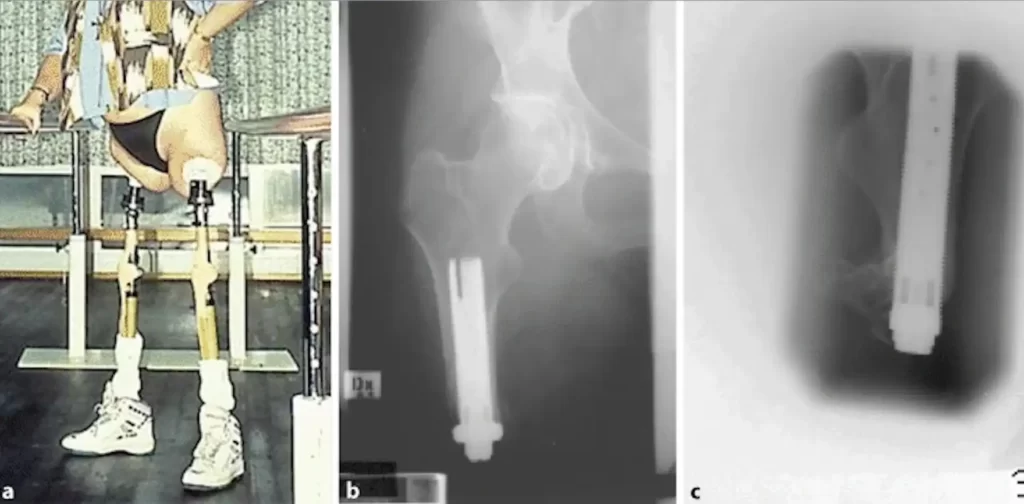Connect With Us!
If you’re considering osseointegration, or you’ve completed your surgery and are now enjoying life with osseointegration, we want to hear from you! Share your ideas, news, stories, feedback and pictures with us here!

The first socket prosthetic, the so-called Capua Leg, is more than 2300 years old. Made of bronze and held in place with rods and leather straps, it was probably crafted by an armourer.
The first written record of prosthetic use comes from 16th Century France, where Royal Surgeon and battlefield medic Ambroise Paré worked to fit artificial limbs to soldiers with both upper and lower limb loss who had been wounded in combat. One such soldier, an Army Captain, is recorded as having worn one of Paré’s mechanical hands into battle.

Between the 16th and 19th Centuries there were further developments in prosthetic technology.
In the late 17th century, Dutch surgeon Pieter Verduyn developed a below-knee prosthetic with hinges allowing for knee movement, and also developed one of the first true flap amputations.
Prosthetic technology continued to be refined through the 19th and early 20th centuries: first with the Pott’s ‘Angelsey Leg’ (c. 1800), then with Selpho’s ‘Selpho Leg’ (c. 1839). The huge number of amputations performed during the American Civil War (1861-1865) prompted massive developments.
At the beginning of the 20th century, British pilot André Marcel Desoutter, created the first aluminium prosthesis.
The phenomenon of osseointegration, the in-growth of bone into the surface of an artificial implant, was first recognised in animal models in 1940.
It was pioneered by Swedish surgeon Per-Ingvar Brånemark, who completed the first osseointegrated dental implantation procedure in 1965. These first dental implants remained in place for over 40 years.

Throughout the 1970s and 1980s, the technology of osseointegration developed, and became increasingly accepted within the scientific and surgical community. This led to the investigation of other potential applications of the technology.

The first osseointegrated implant for amputees was fitted on May 5th 1990 by Rickard Brånemark, Per-Ingvar’s son. The patient was a 25-year-old woman who had lost both her legs above the knee in a tram accident aged 15.
The surgery was completed in two stages, over a period of six months. It enabled the patient to walk with the use of crutches and to exercise by cycling. These first implants functioned, as intended, for 23 years.
Brånemark’s early success was followed by further clinical trials during the early 1990s which further developed the application for above knee (transfemoral) amputees, and pioneered the use of osseointegrated implants for below knee (transradial) and digital (thumb and finger) amputees.
The experience of these first osseointegrated amputees was used to improve both the technology of the osseointegrated implant and the techniques used during osseointegration surgery.

In 1998, Brånemark began work to develop standardised protocols for two-stage osseointegration surgery, the osseointegrated implant itself and the postoperative rehabilitation process for patients.
This became known as OPRA: Osseointegrated Prostheses for the Rehabilitation of Amputees. OPRA was based on the use of bone threading and screw-fit implants.

In 1999, the first “press-fit" osseointegrated implant was fitted in Germany, the patient an 18-year-old male with an above-knee amputation.
This implant was called the Integral Leg Prosthesis (ILP) and included a number of innovations with benefits for stability, weight-bearing and mobilisation.

The next generation of press-fit implants is represented by the Osseointegrated Prosthetic Limb (OPL), designed by Professor Dr Munjed Al Muderis and colleagues.
Typically implanted during a single stage surgery which offers a shorter recovery time for amputees, the OPL reflects the state-of-the-art of biomechanical engineering and materials science, as well as additive manufacturing technologies which enable the best possible fit for every patient.
To date, more than 1000 patients have been successfully implanted with the OPL.
If you’re considering osseointegration, or you’ve completed your surgery and are now enjoying life with osseointegration, we want to hear from you! Share your ideas, news, stories, feedback and pictures with us here!

The Osseointegration Group exists to enable amputees worldwide to improve their quality of life through the application of clincal expertise and technical and technological innovation.
Information provided via this website is for educational and communication purposes only. The material presented is neither intended to convey the only, nor necessarily the best, method or procedure, but rather represents techniques and procedures used by The Osseointegration Group (OG). OG disclaims any and all liability for injury and/or other damages which result from an individual using techniques presented on this website. To the best of our knowledge, we believe the information presented is current and applicable to work being done by orthopaedic surgeons worldwide